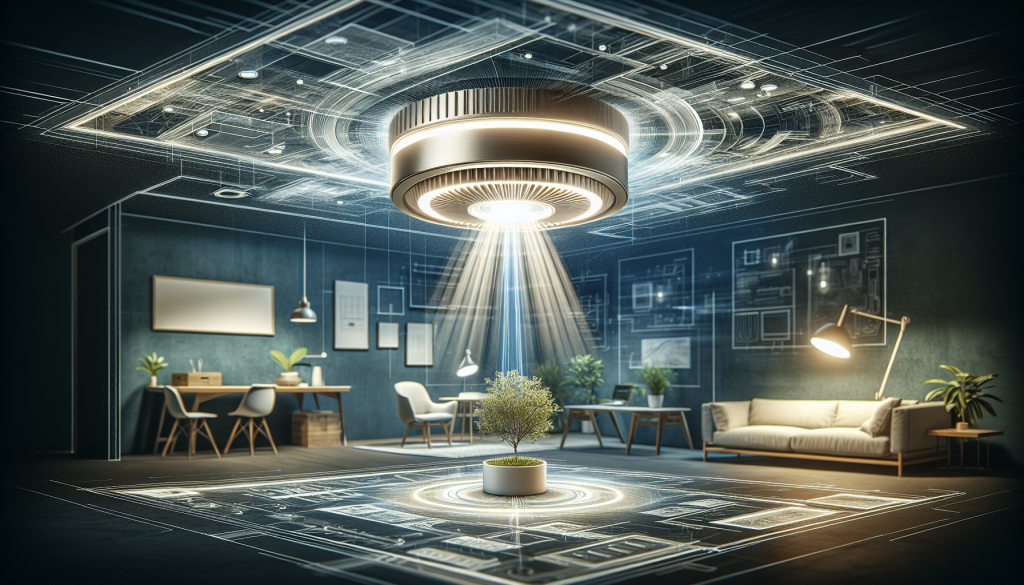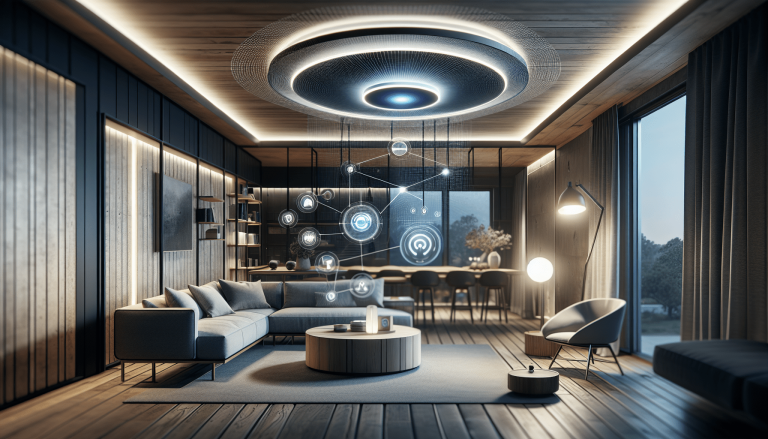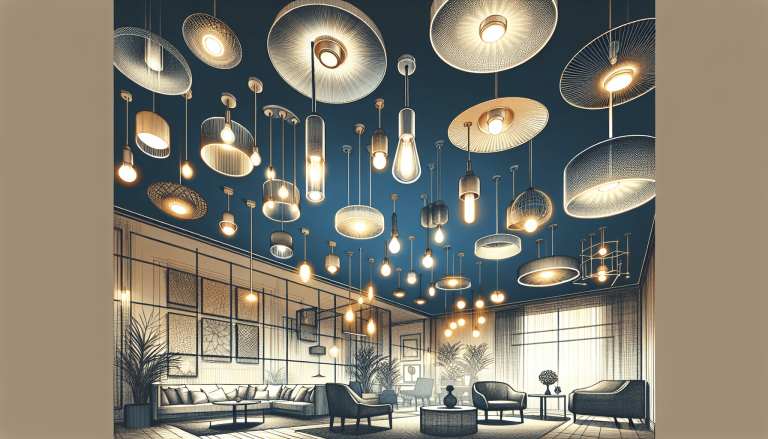Imagine walking into a brightly lit room that warmly welcomes you with its soft and efficient ceiling lights. In this ultimate guide, you will discover the key benefits of energy-efficient ceiling lights and how they can transform your living spaces. From saving money on your electricity bills to reducing your environmental footprint, these ceiling lights are not only practical but also stylish. Get ready to embark on a journey of illuminating your home in a sustainable and cost-effective way.
Table of Contents
ToggleBenefits of Energy-Efficient Ceiling Lights
Reduced energy consumption
Energy-efficient ceiling lights are designed to consume less energy compared to traditional lighting fixtures. By using advanced technologies such as LED and CFL, these lights are able to produce the same amount of light with significantly lower wattage. This means that you can enjoy a well-lit room while minimizing your overall energy consumption.
Lower electricity bills
One of the major perks of using energy-efficient ceiling lights is the potential for lower electricity bills. Since these lights consume less energy, your monthly electricity expenses can be significantly reduced. Over time, the savings can add up and have a positive impact on your household budget.
Environmentally friendly
Another important benefit of energy-efficient ceiling lights is their positive impact on the environment. By reducing energy consumption, these lights help to lower greenhouse gas emissions and contribute to a cleaner and more sustainable earth. With the growing concern over climate change and environmental issues, choosing energy-efficient lighting options is a responsible choice.
Different Types of Energy-Efficient Ceiling Lights
LED Ceiling Lights
LED ceiling lights have gained immense popularity in recent years due to their energy efficiency and long lifespan. LED stands for Light Emitting Diode, and these lights use semiconductors to produce light. They are incredibly efficient, consuming up to 80% less energy than traditional incandescent bulbs. LED ceiling lights are also known for their durability, making them a cost-effective choice in the long run.
CFL Ceiling Lights
Compact Fluorescent Lamp (CFL) ceiling lights are another energy-efficient option. These lights use a different technology compared to LED lights, but they are still able to provide significant energy savings. CFLs are known for their bright light output and longevity. They may take a few minutes to reach their full brightness, but once they do, they can illuminate a room effectively.
Halogen Ceiling Lights
While halogen ceiling lights are not as energy-efficient as LED or CFL lights, they are still considered more efficient than traditional incandescent bulbs. Halogen lights use a halogen gas to produce light, resulting in a brighter and whiter light compared to incandescent bulbs. They also have a longer lifespan and can be dimmed easily, providing flexibility in lighting options.
Factors to Consider When Choosing Energy-Efficient Ceiling Lights
Brightness and Lumens
The brightness of a ceiling light is measured in lumens. It is crucial to consider the desired brightness level for each room when selecting energy-efficient ceiling lights. A brighter light may be required for areas such as the kitchen, while a softer and more ambient light may be preferred for the bedroom. Understanding the lumens output of different light fixtures will help you choose the right lighting for each space in your home.
Color Temperature
Color temperature refers to the color appearance of the light emitted by a bulb. It is measured in Kelvin (K) and is an important consideration when selecting energy-efficient ceiling lights. Lower Kelvin values produce a warm, yellowish light, while higher values produce a cooler, bluish light. Choosing the right color temperature can greatly impact the ambiance and overall feel of a room.
CRI (Color Rendering Index)
The Color Rendering Index (CRI) measures how accurately a light source can render colors. It is particularly important in areas such as the kitchen, where accurate color representation is crucial. A higher CRI value indicates better color rendering, ensuring that objects and surfaces appear natural under the light. When choosing energy-efficient ceiling lights, consider the CRI value to ensure that your lighting enhances the aesthetics of your space.
Energy Star Certification
Energy Star certification is a reliable indicator of energy efficiency and quality. When shopping for energy-efficient ceiling lights, look for products that bear the Energy Star label. These lights have undergone rigorous testing to meet strict energy efficiency and performance criteria. Choosing Energy Star-certified lights not only ensures energy savings but also guarantees long-lasting and reliable lighting solutions.
Installing Energy-Efficient Ceiling Lights
Safety precautions
Before installing energy-efficient ceiling lights, it is important to prioritize safety. Make sure to turn off the power to the existing light fixture at the circuit breaker before starting any installation work. Have a non-contact voltage tester on hand to confirm that the power is off before proceeding.
Replacing existing fixtures
If you are replacing an existing ceiling light fixture with an energy-efficient one, start by removing the old fixture. Detach the wires connecting the old fixture to the electrical box, and then attach the wires of the new fixture. Secure the new fixture to the ceiling according to the manufacturer’s instructions.
Wiring and electrical connections
When installing energy-efficient ceiling lights, it is vital to ensure proper wiring and electrical connections. Follow the manufacturer’s instructions carefully and be sure to connect the wires correctly. Use wire connectors to join the wires securely and cover them with a wire nut. Double-check your connections before turning the power back on and testing the new ceiling light.
How to Calculate Energy Savings with Energy-Efficient Ceiling Lights
Wattage comparison
To calculate energy savings, start by comparing the wattage of the energy-efficient ceiling light with the wattage of the traditional light it is replacing. The energy-efficient light should have a lower wattage, indicating lower energy consumption.
Average daily usage
Next, determine the average number of hours the ceiling light is used each day. Multiply this number by the wattage difference between the traditional light and the energy-efficient light. The result will give you the daily energy savings in watt-hours.
Annual energy savings
To calculate the annual energy savings, multiply the daily energy savings (in watt-hours) by the number of days in a year. Divide the result by 1,000 to convert watt-hours to kilowatt-hours (kWh). This final calculation will give you an estimate of the amount of energy you can save annually by using energy-efficient ceiling lights.
Maintenance Tips for Energy-Efficient Ceiling Lights
Cleaning and dusting
Regular cleaning and dusting of energy-efficient ceiling lights are important to maintain their performance and prolong their lifespan. Use a soft cloth or a duster to gently wipe down the surface of the light fixtures. Avoid using abrasive materials or harsh chemicals that can damage the lights.
Replacing bulbs
When the bulbs in your energy-efficient ceiling lights reach the end of their lifespan, it is important to replace them promptly. Follow the manufacturer’s instructions for bulb replacement and ensure that you are using bulbs of the correct wattage and type. Regular bulb replacement will ensure that your ceiling lights continue to provide optimal lighting efficiency.
Checking for flickering or buzzing
If you notice any flickering or buzzing from your energy-efficient ceiling lights, it could be a sign of an underlying issue. Check for loose connections, damaged wires, or faulty bulbs. If the problem persists, it is recommended to consult a professional electrician for further inspection and troubleshooting.
Integration with Smart Home Systems
Compatibility with smart bulbs and dimmers
Energy-efficient ceiling lights can often be integrated with smart home systems, providing additional functionality and convenience. Check the compatibility of the light fixtures with smart bulbs and dimmers to take advantage of features such as remote control, voice control, and customizable scheduling.
Voice control and scheduling options
By connecting your energy-efficient ceiling lights to a smart home system, you can control them using voice commands. Whether it’s adjusting the brightness or turning the lights on and off, voice control adds a new level of convenience. Additionally, scheduling options allow you to automate your lighting based on your daily routine, optimizing energy efficiency and enhancing home security.
Common Issues and Troubleshooting
Flickering lights
Flickering lights can be caused by various factors, including loose connections, incompatible dimmers, or faulty bulbs. To troubleshoot flickering lights, check the connections between the light fixture and the electrical supply. Ensure that you are using compatible dimmers and that the bulbs are properly seated in the socket. If the problem persists, it is advisable to seek professional assistance.
Buzzing noises
Buzzing noises from energy-efficient ceiling lights can be annoying and indicate an underlying problem. The most common cause is a compatibility issue between the dimmer and the light fixture. Ensure that you are using a dimmer that is compatible with your energy-efficient lights. If the buzzing persists, consult a professional electrician.
Inconsistent lighting levels
Inconsistent lighting levels can be caused by faulty bulbs, imbalanced wiring, or compatibility issues with dimmers. Check the bulbs to ensure they are functioning properly and are of the correct type and wattage. If the problem persists, it may be necessary to consult a professional electrician to diagnose and resolve the issue.
Energy-Efficient Ceiling Lights for Different Rooms
Living room
In the living room, consider energy-efficient ceiling lights that provide a warm and inviting ambiance. LED or halogen ceiling lights with dimming capabilities are ideal for creating the perfect atmosphere for relaxation and entertainment.
Bedroom
For the bedroom, choose energy-efficient ceiling lights that offer a soft and soothing light. LED or CFL lights with warm color temperatures are ideal for promoting relaxation and creating a calming environment.
Kitchen
In the kitchen, bright and task-oriented lighting is essential. LED or CFL ceiling lights with a high color temperature and excellent color rendering are recommended for optimal visibility and accurate color representation.
Bathroom
In the bathroom, a combination of bright and soft lighting is often preferred. LED ceiling lights with a mix of warm and cool color temperatures can provide the ideal lighting conditions for grooming and relaxation.
Popular Brands and Products
Philips Hue Ceiling Lights
Philips Hue offers a wide range of energy-efficient ceiling lights that can be controlled remotely and integrated with smart home systems. Their products come in various styles and finishes, allowing homeowners to choose the perfect lighting solution for their space.
Cree LED Ceiling Lights
Cree is known for its high-quality and energy-efficient LED lighting products. Their LED ceiling lights offer excellent performance, long lifespan, and energy savings. Cree’s products are known for their durability and reliability.
EcoSmart CFL Ceiling Lights
EcoSmart offers a range of energy-efficient CFL ceiling lights that provide bright and efficient lighting solutions. Their products are designed to be long-lasting and eco-friendly, making them a popular choice for environmentally conscious consumers.
In conclusion, energy-efficient ceiling lights offer a range of benefits including reduced energy consumption, lower electricity bills, and environmental friendliness. When choosing energy-efficient ceiling lights, consider factors such as brightness, color temperature, CRI, and Energy Star certification. Proper installation, maintenance, and integration with smart home systems can enhance the efficiency and functionality of these lights. Whether it’s for the living room, bedroom, kitchen, or bathroom, there are energy-efficient ceiling lights available to suit every room in your home. Popular brands such as Philips Hue, Cree, and EcoSmart offer a wide selection of reliable and high-performance products. By making the switch to energy-efficient ceiling lights, you can create a brighter, more sustainable, and cost-effective lighting solution for your home.








